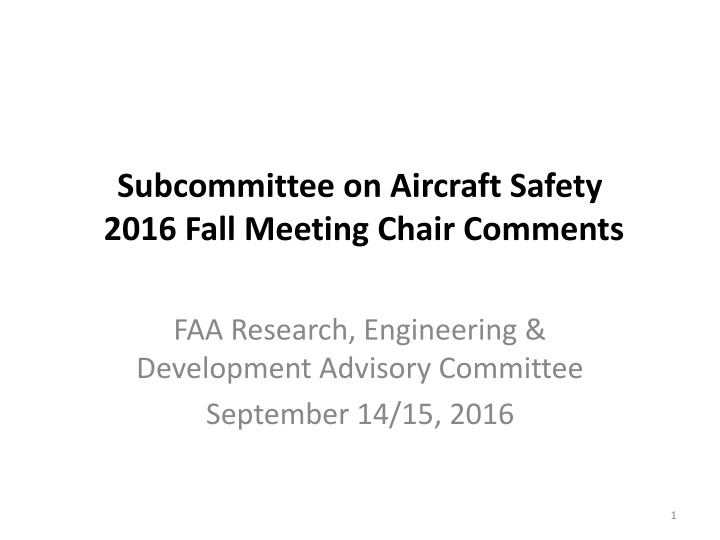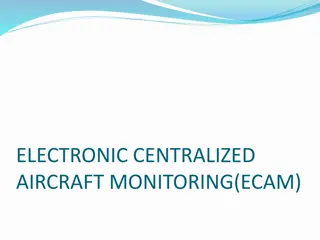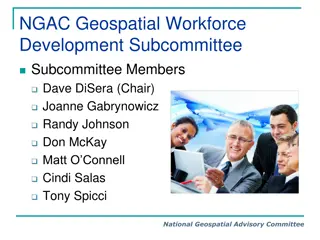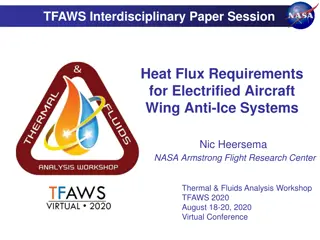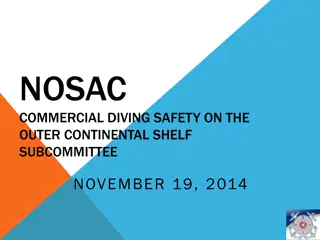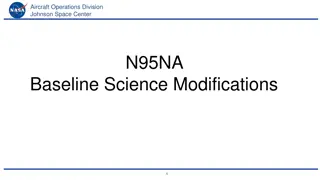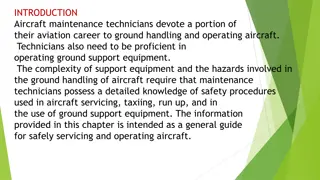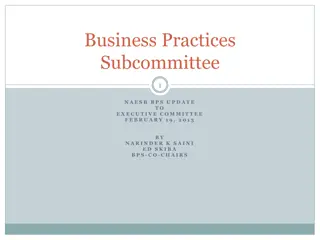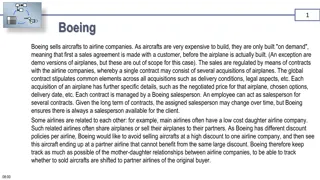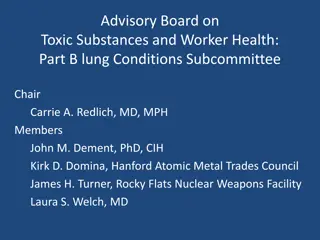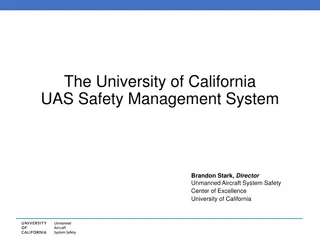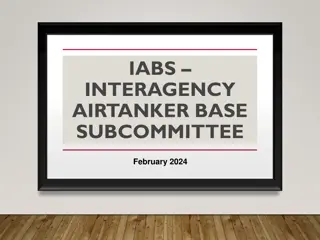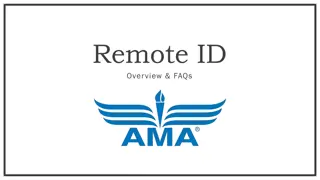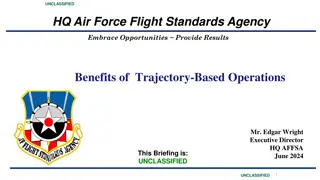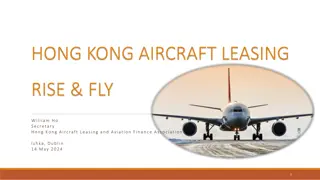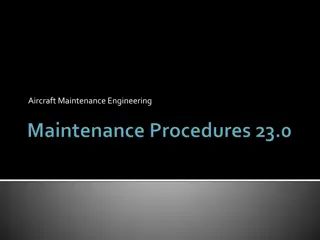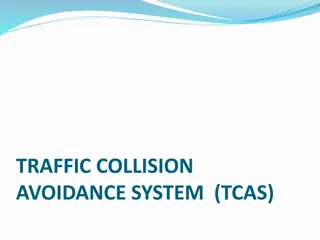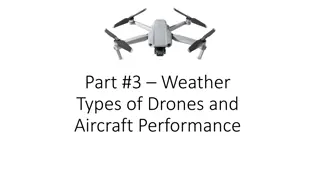FAA Subcommittee on Aircraft Safety 2016 Fall Meeting Recommendations
The Subcommittee on Aircraft Safety provided findings and recommendations regarding UAS integration, funding impact on safety research, and strategic planning. Industry needs a clear strategy for UAS activities, improved data collection, and more cohesive organizational structures. Congressional funding reallocations for UAS have affected other critical safety research areas, prompting recommendations for reviews and alternative funding approaches.
Download Presentation

Please find below an Image/Link to download the presentation.
The content on the website is provided AS IS for your information and personal use only. It may not be sold, licensed, or shared on other websites without obtaining consent from the author.If you encounter any issues during the download, it is possible that the publisher has removed the file from their server.
You are allowed to download the files provided on this website for personal or commercial use, subject to the condition that they are used lawfully. All files are the property of their respective owners.
The content on the website is provided AS IS for your information and personal use only. It may not be sold, licensed, or shared on other websites without obtaining consent from the author.
E N D
Presentation Transcript
Subcommittee on Aircraft Safety 2016 Fall Meeting Chair Comments FAA Research, Engineering & Development Advisory Committee September 14/15, 2016 1
Reminder - Spring 2016 SAS Meeting Objectives Provide meaningful input to FAA Safety leadership considering: UAS Research Priorities Review of FY18 Safety Research Portfolio Further evolution of Emerging and Future Issues Input on FY19 Research Guidance Document 2
Findings and Recommendations UAS Findings Industry needs high level strategy and single, overarching, plan with clear objectives and milestones (roadmap) Integration and connection between various elements of UAS activity is not clear UAS CONOPS lacks broad stakeholder input and is likely incomplete Lack of coherent, current, UAS safety data is a shortcoming and could inform future data needs Pathfinder scope is limited when considered against the scope of expected operational demands COE connection to the overall strategy and research priorities is unclear Recommendations Finalize and distribute a coherent strategy for safe and efficient UAS integration. Implement a cohesive organizational structure and place overall responsibility in one person or organization Update and vet CONOPS, concept maturity plan and prioritized research requirements with all stakeholders Begin comprehensive effort to collect UAS operational and safety data Initiate research effort to understand what long term UAS safety data is required A11H.SSM.11 (Safety Oversight Management System) research be expanded to include UAS Accelerate Pathfinder program to include more complex types of operations with accelerated schedules Future ASSURE projects should be consistent with FAA research needs and priorities based on strategic plan Develop a process to ensure capable institutions not currently affiliated with ASSURE can be engaged 3
Findings and Recommendations UAS Funding Impact on Other Safety Research Portfolio Items Findings Contract funding for UAS has been significantly expanded, by congressional re-allocation, over the requested amounts, each of the past two years 2015- $7210k to $13210k 2016 - $8150k to $16022k This has come at the expense of other necessary safety research. For example: Human Factors reduced $5100k in 2016 Aeromedical reduced $1500 in 2016 Weather reduced $1600 in 2016 Recommendations FAA conduct review to assess the collateral impact of these congressionally mandated re-allocations on existing safety efforts FAA re-review BLI s or RE&D tasks that are provided funding in one year but then halted in interim year(s) with consideration of balancing funds to minimize impact FAA consider developing alternate approach to incrementally fund UAS that does not result in reductions to existing prioritized research 4
Findings and Recommendations Immediate needs for Additive Manufacturing Certification Support (Repeat Item) Findings Near term strategy is required to help the certification directorates assess type designs or type design changes which incorporate parts produced utilizing additive / advanced manufacturing methods Industry continuing to accelerate efforts to incorporate additive manufacturing technologies as full- scale production processes Continued slow progress accelerating the development of a FAA Additive Manufacturing Roadmap and identification of focused research. Current focus on: Certification Policy Memos Tactical Project Plans Recommendations Expedite guidelines describing the considerations which should be assessed relative to the incorporation of parts produced by Additive Manufacturing FAA assess the need for additional research to supplement the initial guidelines for the potential longer-term codification of Additive Manufacturing guidance 5
Findings and Recommendations Advanced Materials Research Findings Fall 2014 SAS identified Emerging Issue of Certification of Advanced Materials and Structural Technologies As new aircraft and engine designs drive towards advanced performance, new material systems and structural concepts will continue to be introduced that are significantly different. FAA needs to stay abreast of industry changes to build its knowledge to make certification decisions and support regulations, standards, guidance materials and training Four specific areas of concern include: Hot corrosion on engine rotor life and incorporation of work into DARWIN Advanced Non Destructive Evaluation (NDE) of critical components Cold dwell fatigue modelling in Titanium Computational Material Science research to understand microstructural changes in critical materials Recommendations FAA continue to prioritize funds for further development and validation of hot corrosion into DARWIN code Continue the study of innovative NDE techniques and assist in the transition of the most promising methods to manufacturers and overhaul facilities Work collaboratively with industry and AFRL to fully understand texturing in Titanium to prevent cold dwell fatigue Continue to work collaboratively with industry and USAF to develop computational methods into DARWIN code to enhance life prediction 6
Findings and Recommendations Ice Crystal Icing (ICI) Engine Test and Analysis Capabilities Findings SAS presented a comprehensive review of icing related safety research Both the Engine Harmonization Working Groups (EHWG) and Technical Community Representative Groups (TCRG) identified need for additional ICI engine testing Research in avoidance of ICI is ongoing although it is not practical to expect complete environmental condition avoidance Recommendations Means must be designed, analyzed, and lab tested, to predict and reduce ice crystal icing susceptibility for engines RE&D funding for A11.D (Research on Ice Crystal and SLD Icing Conditions) be prioritized at a higher level in FY18 and beyond to support engine testing 7
Since our last meeting Late April Meeting with Peggy Gilligan and AVS Management Team 2018 AVS Research Plan approved Emerging Issues included in AVS 2019 Strategic Guidance Document Overall SAS efforts endorsed AVS leadership desire to meet with REDAC 8
Since our last meeting cont May Full REDAC meeting Detail discussions on UAS SAS recommendations endorsed Meta Issues identified as: Real need to communicate the UAS strategies and assumptions Support the development of high level strategic research areas Focus for future REDAC meetings: Where are the big data analysis opportunities? What are the critical questions around big data? 9
Fall 2016 SAS Meeting Objectives Continual input on guidance to the research portfolio 2019 Begin to explore REDAC/Administrators Big Data questions Maximize value out of our time with Peggy Gilligan and the AVS Management Team 10
SAS Approach Desire to continue to build upon work of prior SAS meetings Keep previously identified Emerging and Future concerns in the forefront to assist in identifying research gaps Meeting the advisory needs of the AVS Management Team CSTA and outside industry/FAA expert participation whenever possible Deep Dives into significant items as defined by: Significant research dollars committed REDAC priority items Committee concern items (Emerging issues) 11
Agenda Development Guide Meeting s agenda built with a strong connection to previously identified Emerging and Future, and high level REDAC, issues Big Data Questions (Full REDAC) Big Data and Data Analytics Discussion UAS (Full REDAC) UAS CONOPS and Maturation Plan Discussion Real Time System-wide Safety Assurance (Emerging Issue) NASA and FAA Updates on their activities Committee discussion on gaps Cert of Advanced Materials and Structural Technologies (Emerging Issue) Additive Manufacturing Discussion AVS Leadership team (AVS Needs) AVS Management Team Strategic Research Discussion 12
For Consideration During the Meeting What do we want to discuss with the AVS leadership team? Are we meeting their needs? What help do we need to do a better job? Are SAS Emerging and Future issues still the right ones? Should they be changed or adjusted? What else do we need to evaluate/deep dive into to better inform us? Short term? Long term? 13
Appendix 14
Fall 2014 - SAS Emerging Issues Reminder Real time system-wide safety assurance Dependability of increasingly complex systems Certification of advanced materials and structural technologies High density energy storage, management, and use 15
Fall 2014 - SAS Future Opportunities- Reminder Commercial space integration with the National space system General aviation s role in safety systems development Effects of breakthrough medical technologies on FAA medical certification standards Identification and funding of strategic research and development 16
Real Time System-wide Safety Assurance Why? Ongoing advances in sensor and network technology, computation, communications and integration Ongoing advances in data analysis capability Ongoing developments in accelerated data access Ongoing data protection issues Advances in system-on-system modeling and prognostics including integrated human performance monitoring Research Needs Continued development of real time, continuous, safety analysis and assurance tools including; Integration of advanced tools into more highly automated safety assurance systems 17
